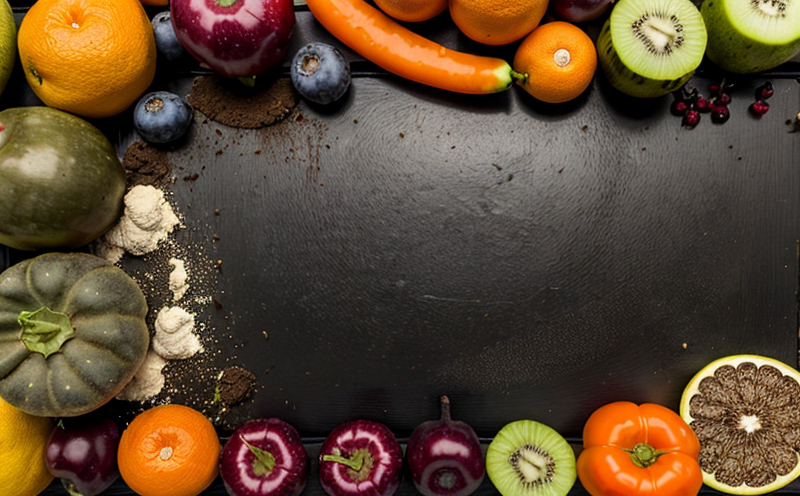AOAC 991.32 Vitamin A Analysis in Vegetable Products
The AOAC (Association of Official Analytical Chemists) method 991.32 is a widely recognized standard for the determination of vitamin A, specifically β-carotene and its provitamin A activity, in vegetable products such as carrots, spinach, and kale. This method is crucial for ensuring food safety and quality, particularly when dealing with products that are sources of essential nutrients like vitamin A.
Vitamin A is an important nutrient that plays a significant role in maintaining vision, supporting immune function, and promoting cell growth. In the context of vegetable testing, this analysis is particularly relevant due to its high content of β-carotene, which can be converted into active vitamin A by the body. This conversion process can vary depending on individual factors such as age and health status.
The AOAC 991.32 method involves extracting β-carotene from vegetable samples using a solvent system typically consisting of methanol and ethanol. The extracted carotenoids are then separated via chromatography, followed by quantification through spectrophotometric analysis. This approach ensures accurate measurement of the provitamin A activity in vegetables.
For effective testing, proper specimen preparation is essential. Samples should be homogenized to ensure even distribution of β-carotene throughout the sample matrix. After extraction and separation, the carotenoids are analyzed using a spectrophotometer set at 453 nm, which corresponds to the absorption peak of β-carotene.
The AOAC 991.32 method is not only used in quality assurance but also aids in compliance with international standards such as ISO and FDA requirements for food safety and labeling accuracy. By adhering to this standard, laboratories can ensure that their clients receive reliable results that meet global regulatory expectations.
Real-world applications of AOAC 991.32 include not only quality control but also research aimed at improving the nutritional value of vegetables through breeding programs or post-harvest processing techniques. Understanding vitamin A content is vital for developing new varieties with enhanced nutrient profiles, as well as optimizing storage conditions to preserve β-carotene levels.
Given its importance in public health and dietary recommendations, this method has seen increasing demand across various sectors including agriculture, nutrition science, and food manufacturing. As more emphasis is placed on sustainable agriculture practices, accurate measurement of vitamin A content becomes an integral part of ensuring that crops meet nutritional standards.
Scope and Methodology
| Step | Description |
|---|---|
| Sample Preparation | Homogenize vegetable samples and extract β-carotene using methanol and ethanol. |
| Separation | Use chromatography to separate carotenoids from other components. |
| Quantification | Analyze the extracted carotenoids at 453 nm with a spectrophotometer for accurate quantification. |
| Reporting | Generate reports detailing vitamin A content, including β-carotene levels and provitamin activity. |
The AOAC method 991.32 provides a robust framework for analyzing vitamin A content in vegetables. By following these steps, laboratories can ensure consistent and accurate results that are critical for meeting regulatory requirements and supporting research initiatives aimed at improving food safety and quality.
Industry Applications
The AOAC 991.32 method finds application in multiple industries beyond just academia and research laboratories. Quality managers in agricultural firms use this methodology to ensure that harvested vegetables meet specified vitamin A content standards set by regulatory bodies like the FDA or EU Commission.
In food manufacturing, compliance officers rely on AOAC methods to verify that processed products comply with labeling claims regarding nutritional content. R&D engineers may employ these techniques during product development stages to identify optimal growing conditions or processing methods that enhance β-carotene retention in vegetables.
For procurement teams within large corporations, accurate measurement of vitamin A content helps in selecting suppliers who provide consistent quality produce. This ensures not only compliance with internal standards but also contributes positively towards corporate social responsibility goals related to nutrition and health promotion.
The application of AOAC 991.32 extends beyond these sectors into retail where it supports the development of healthier product lines for consumers seeking information about vitamin A content in their food choices.
Environmental and Sustainability Contributions
By accurately measuring vitamin A content using AOAC 991.32, there are significant environmental benefits that can be realized. Ensuring high levels of β-carotene retention during cultivation practices promotes sustainable agriculture by encouraging farmers to adopt methods that maintain soil health and biodiversity.
The ability to measure provitamin activity accurately also allows for better management of post-harvest processes such as refrigeration or drying, which helps prevent loss due to oxidation while enhancing shelf life. This contributes positively towards reducing food waste and improving overall resource efficiency within supply chains.
Furthermore, understanding the conversion rates of β-carotene into active vitamin A can inform breeding programs aimed at creating more nutrient-dense crops. Such efforts contribute not only to improved human nutrition globally but also support long-term sustainability goals by optimizing land use and water resources.





